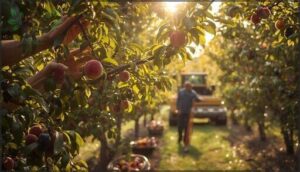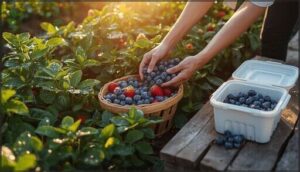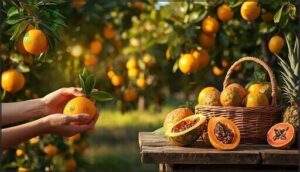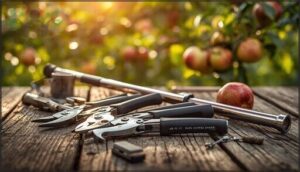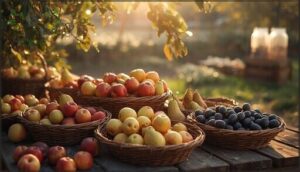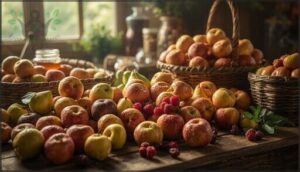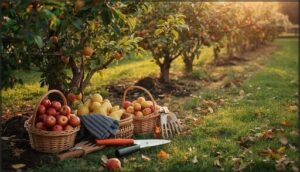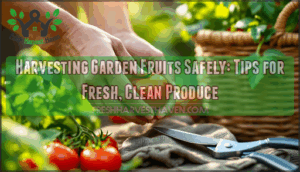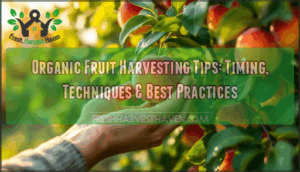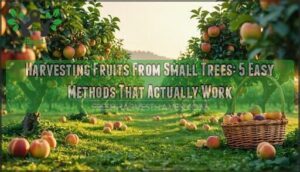This site is supported by our readers. We may earn a commission, at no cost to you, if you purchase through links.
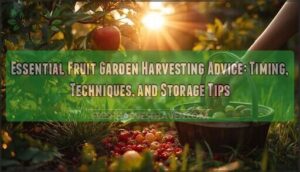
There’s an art to catching fruit at its peak, a science in getting it from branch to basket without bruises or spoilage. Learn
Table Of Contents
Key Takeaways
- Harvest fruit at peak ripeness by watching for color, texture, scent, and weight changes, and pick early in the day to lock in freshness.
- Use gentle handling, proper tools, and immediate sorting to prevent bruises, reduce spoilage, and maximize fruit quality.
- Maintain tools with regular cleaning and sanitation to prevent disease and safeguard both your harvest and your garden’s long-term health.
- Store fruit with attention to temperature, humidity, and preservation methods to extend shelf life and keep flavor and nutrition intact.
Choosing The Right Time to Harvest
Figuring out when to pick your fruit can feel a little mysterious if you’re not sure what to watch for. A few key signs and seasonal cues will help you get it right every time.
Let’s walk through what to notice so you harvest at the perfect moment.
Identifying Signs of Fruit Ripeness
Spotting fruit ripeness is part art, part science. Color indicators often lead the way—think apples shifting from green to yellow or cherries deepening to crimson. Texture changes, like a gentle give under slight pressure, act as silent ripeness cues.
Trust your nose too: sweet aroma signals fruit maturity, while weight and chemical measurements confirm the perfect harvest moment. Knowing the fruit’s classification helps determine if it will continue to ripen after picking.
Morning Vs. Afternoon Harvesting
After recognizing ripeness, harvest timing becomes a balancing act. Morning harvesting’s cooler air locks in moisture retention and helps fruit maintain crispness, bright flavor profiles, and high fruit quality. Afternoon harvests, especially during peak heat, can stress plants and spike spoilage risks.
For most fruits, picking early aids flavor and longevity, making your harvest both sweet and resilient. Optimized harvest timing can increase garden yield.
Seasonal Timing for Popular Fruits
You’ll soon find that harvest timing is practically an art form, dictated by nature’s calendar.
Apple harvest swings from late summer through fall. Berry seasons sprint from spring to early autumn, while citrus timelines stretch across colder months. Stone fruit favors warm midsummer, and tropical periods rely on regional quirks.
Each fruit’s ripening signals shape that perfect, seasonal harvest timing.
Effects of Climate and Weather on Harvest Timing
Of course, seasonal harvest timing is never just about the calendar—weather always has tricks up its sleeve. Temperature impacts can advance bloom and fruit maturity, while rainfall effects, like heavy downpours, can split or spoil fruit almost overnight.
When you factor in extreme events, climate change, and microclimates, it’s clear that smart climate monitoring helps fine-tune your harvest timeframe timing.
Harvesting Techniques for Different Fruit Types
Each type of fruit brings its own quirks when it’s time to harvest. From soft peaches to tiny berries and thick-skinned citrus, the right approach makes all the difference. Here’s what you need to know before picking your next crop.
Stone Fruit Harvesting Methods
Ever tried plucking a sun-warmed peach only to bruise it? Mastering stone fruit harvesting means knowing when and how.
Use these key approaches for top fruit quality:
- Employ hand-picking techniques—gently twist, don’t pull.
- Rely on shaker adjustments for mechanical harvesting.
- Explore ladder-less methods to protect delicate crops.
- Factor in preharvest conditions.
- Harvest at peak ripening for best flavor and storage.
Berry Picking Best Practices
Every handful of berries deserves gentle handling—think of it as coaxing, not grabbing. Wait for peak sweetness: fully colored, no hint of red left on blueberries, strawberries that detach easily.
Sort bruised fruit immediately to minimize damage and boost fruit quality. Transfer promptly to cold storage; delay accelerates spoilage.
For food safety, use clean containers and skip pre-storage washing.
Citrus and Tropical Fruit Harvesting
At the peak of citrus season, watch for ripeness indicators—firm, heavy fruit with vibrant color signals peak flavor. For most citrus trees, gentle twisting or careful cutting preserves skins and shelf life.
In tropical fruit gardens, timing your harvest after cool nights and using precise handling techniques help guarantee premium fruit quality, no matter the weather impacts or pruning effects.
Using Tools: Hand Pruners, Pole Pickers, and More
Harvesting tools shape both your comfort and your yield. Ergonomic tooling like hand pruners and clippers reduce strain, while pole pickers offer safe, ladderless techniques for taller trees. Here’s how effective harvesting tools improve your orchard:
- Ergonomic pruners boost picking efficiency and reduce fatigue
- Pruner maintenance means cleaner cuts, lower tool costs
- Pole fruit pickers let you reach every crop safely
- Market trends favor lightweight, durable designs that keep hands and backs happy
Maximizing Fruit Quality and Reducing Losses
Getting the best from your fruit harvest is all about what you do right after picking. How you handle, sort, and store each fruit makes a world of difference for quality and shelf life.
Here are some steps to help make every harvest count.
Proper Tool Sanitization and Maintenance
Here’s a fact to remember: one dirty pruner can undo a season’s work. Proper tool sanitization and maintenance—using the right Sanitizer Types, regular Disinfection Frequency, and keen Tool Sharpening—keeps your harvesting tools disease-free and reliable.
Simple storage practices and vigilant garden sanitation safeguard fruit quality but also support smart, long-term Disease Prevention.
Gentle Handling to Prevent Bruising
Did you know a simple drop can ruin the fruit you’ve worked so hard to grow? To keep apples, berries, and stone fruit unblemished, remember:
- Minimize drop height with gentle harvest methods.
- Use padded picking containers to absorb shock.
- Train pickers to understand handling force impact and master bruise detection.
Smart fruit handling is the heart of reducing postharvest losses.
Immediate Sorting and Damage Prevention
Right after gentle handling, immediate sorting and damage prevention stand between a bountiful harvest and lost quality. Sorting benefits you twice over: first, it keeps bruised or imperfect fruit out of storage, and second, it opens the door for smarter quality control.
Today’s harvesting techniques and sorting technology minimize damage causes and protect your crop’s economic impact.
Harvesting for Peak Flavor and Nutrition
Once you’ve set aside blemished fruit, pay close attention to prime ripeness and gentle handling. Harvest timing shapes not just fruit flavor but also nutrient retention. Cooler mornings often yield the sweetest results, locking in moisture and antioxidants. Don’t forget, climate effects—like late-season sunshine—can boost anthocyanin content.
Harvesting at peak ripeness on cool mornings preserves both the flavor and nutrition that make your fruit truly exceptional
- Monitor fruit ripening
- Pick early morning
- Use gentle techniques
- Harvest at peak flavor
- Adapt for climate shifts
Post-Harvest Handling and Storage Tips
Bringing in your fruit is just the beginning. What you do right after harvest can make all the difference for taste and shelf life.
Let’s look at your best options for storing and preserving your haul.
Short-Term Storage Solutions
For short-term fruit storage, prioritize temperature control—most fruits do best near 40°F in the fridge, but watch for chilling injury on sensitive types.
Gentle handling and humidity management are also key. Use perforated bags or breathable containers, add a towel to absorb excess moisture, and sort out damaged fruit to prevent spoilage.
Long-Term Storage Methods and Humidity Control
For long-term fruit storage, aim for the right blend of temperature control and humidity. Humidity’s impact is undeniable—too low, and fruit shrivels; too high, and you risk rot.
Keep storage effective by:
- Monitoring humidity often
- Using packaging practices like perforated bags
- Adjusting temperatures for fruit-specific conditions
- Managing condensation control with ventilated containers and moisture barriers
Preventing Spoilage and Extending Shelf Life
With a little foresight, you can turn postharvest handling into your fruit’s best insurance policy. Ethylene management—keeping high producers like apples away from ethylene-sensitive types—slows ripening and prevents spoilage.
Gentle handling, strict temperature and humidity control, and sharp disease control measures mean longer shelf life, less waste, and a lighter economic impact from fruit storage gone wrong.
Food Preservation: Freezing, Drying, and Root Cellaring
After harvest, your fruit preservation toolkit expands with smart choices. Freezing best practices protect texture and taste; drying nutrient retention shines for hikers and snack-lovers alike. Root cellar design lets you savor homegrown apples deep into winter. Comparing each method, you’ll see modern advances—from cryogenic freezing to airtight dried fruit storage—can reshape both short-term and long-term fruit storage at home.
- Flash-freeze berries for maximal flavor
- Dry sliced apples for compact snacks
- Store pears in a cool, humid root cellar
- Use airtight jars for dried fruits’ shelf life
- Embrace preservation comparison for what suits your climate best
Essential Garden Maintenance After Harvest
Once the last basket is full, your work in the fruit garden isn’t quite finished. There are a few steps that set you up for healthier trees and better crops next year.
Here’s what you’ll want to focus on after harvest.
Mulching for Soil Health and Moisture Retention
Think of mulching as wrapping your fruit garden in a protective blanket. Right after harvest, a layer of organic mulch keeps soil moist, shields against extreme temperatures, and slowly enriches the earth with essential nutrients.
This simple garden maintenance step encourages thriving microbes and suppresses weeds, setting the stage for resilient, well-fed fruit trees and less erosion all season long.
Tree Pruning and Care for Next Season
When you want next season’s fruit to outshine this year’s, don’t overlook fruit tree pruning during the dormant season. Proper pruning techniques—removing damaged limbs, correcting shape, and encouraging new growth—boost fruit yield and overall tree health.
This is the heart of post-harvest fruit tree care, blending sustainable practices and smart garden maintenance for long-term fruit care and orchard vitality.
Sanitation Practices to Prevent Disease
Picture your garden as a fortress—debris removal and post-harvest cleaning are its walls. Diseases and pests slip through the smallest cracks if you skip proper sanitation practices.
Tool sanitization, strategic soil management, and smart pruning techniques halt fruit diseases and boost food safety. Think of each clean cut and tidy orchard as an investment in next season’s harvest.
Planning for Continuous Fruit Production
If you’re aiming for harvest scheduling success, focus on staggered planting and fruit variety selection. Choosing fruit varieties with different ripening times, practicing crop rotation, and fine-tuning orchard management ensures steady fruit yields.
Pair these with strategic storage solutions and well-timed planting, and your garden’s bounty won’t just arrive in one flush—it’ll weave through the whole season.
Frequently Asked Questions (FAQs)
How can pests be managed during harvest?
Just like locking the garden gate at dusk keeps critters out, timing your harvest early, practicing tool sanitization, and using biological or chemical controls work together as powerful pest management—reducing pest damage while optimizing fruit quality.
What are safe ways to harvest tall trees?
Harvesting tall trees safely involves prioritizing ladder alternatives like pole pickers, maintaining clear drop zones, and determining tree height before work.
Climbing safety focuses on secure tie-ins and tool selection, reducing risks during fruit harvesting with proper harvesting techniques and methods.
Are there fruits that ripen after picking?
Yes, some fruits—called climacteric fruits—continue ripening after picking thanks to ethylene gas. This climacteric ripening triggers post-harvest changes in texture and sweetness.
Non-climacteric fruits, however, don’t ripen after harvest and must be picked fully ripe.
How to handle surplus fruit after harvest?
Surplus fruit after harvest can be managed with surplus redistribution, composting options, use as animal feed, or biofuel conversion.
Smart fruit storage techniques, including short and long-term solutions, humidity control, and preservation methods, all extend shelf life and reduce economic impact.
What are signs of nutrient deficiencies in fruit?
“A chain is only as strong as its weakest link.” In fruit, Boron Deficiency, Calcium Shortage, low Nitrogen Levels, Potassium Deficit, or Magnesium Lack each reveal themselves through unique blemishes and deformities, disrupting fruit nutrition, maturity, and quality.
Conclusion
Perhaps your neighbor’s pears are plotting to outshine your plums, but armed with real fruit garden harvesting advice, you’ll outwit even the craftiest crops. With timing as your compass and technique your trusty spade, you become both steward and strategist.
Berries yield, apples bow, and citrus gleams at your approach. Harvest isn’t about greed—it’s practiced generosity. Your hands bring flavor forward and lay the groundwork for next year’s bounty.
That’s worth savoring—and maybe, just maybe, sharing.
- https://www.jacksonandperkins.com/blog/garden-blogs/fruitful-harvest/b/fruitful-harvest/
- https://www.gardenersedge.com/c/garden-harvest-tools?p=3
- https://extension.umn.edu/planting-and-growing-guides/harvesting-and-storing-home-garden-vegetables
- https://www.croptracker.com/blog/apple-and-pear-harvest-outlook-2025.html
- https://albopepper.com/growing-fruit-trees-barrier-intro.php

